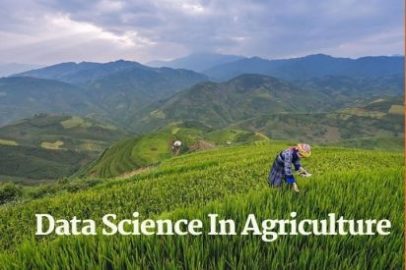Data science and big data are increasingly finding their way into agriculture to create economic and ecological production conditions adapted to the market. Digital networking is therefore playing an increasingly important role.
According to the German Farmers’ Association, “Agriculture 4.0” has arrived in every fifth farm.
This means the use of Industry 4.0 applications such as
- Self-regulating production processes
- Machines that communicate with each other (M2M)
- Autonomous vehicles
- Integration of production with the latest information and communication technology
- Decision making through computer programs
What Does Digitization Look Like In Agriculture?
Computer science and electronics have shaped everyday agricultural life for many years.
- Agricultural machines with intelligent technologies enable automated work processes in the field and the yard
- Weather apps, drones, and other data management systems help optimize soil and harvesting processes
- Cloud solutions, for example for essential fertilization and nitrogen fertilization, enable plants to be supplied better and more efficiently
- Complex operations, such as silage maize or sugar beet harvest, can be monitored in real-time and jointly organized
- Feed robots, measuring devices for determining milk content, or climate control systems make a significant contribution to animal welfare and environmental protection and serve to make work easier
- Animal behavior can be selected and evaluated through new developments in sensor technology
Use Of Remote-Controlled Drones And Helicopters
Remote-controlled helicopters and multicopters for civil purposes are used in agricultural practice. Wildlife rescue (fawn identification) with infrared detection, soil, fertilizer, crop protection monitoring, and crop protection application are possible fields of application with enormous amounts of data.
Use Of Agricultural-Specific Weather Data With The Help Of Weather Stations
Dealing with soil, water, and air can be improved with agricultural-specific weather data. A close-knit network of weather stations and phenological observations are therefore of great informational value.
Automated Work Processes Through Computers: Automated Irrigation As An Example
The irrigation of plants without damaging the water table and salinizing the soil is essential for the farmer. In digitized agriculture, this task is carried out by automatic irrigation computers.
Precision And Smart Farming: What Is It, And What Does It Lead To?
Precision farming means that agricultural processes should be designed as precisely and optimally as possible. In this way, water, diesel, pesticides, and fertilizers can be saved in a targeted manner.
Optimizing the intelligent control of these processes, on the other hand, is the task of intelligent farming.
Modern production processes in agriculture generate large and varied amounts of data. Sensor data from agricultural machines, satellite, aerial images, weather and climate data, yields, cultivation methods, and soil properties result in a detailed picture of the relevant production processes.
The intelligent use and analysis of this amount of data through modern data science methods have the potential to expand knowledge about these processes significantly and, at the same time, to optimize operations in a variety of ways.
What Problems Does Agricultural Science Have, And How Can Big Data Help?
The European Commission already warned in 2011: “Many of today’s food-producing systems endanger the capacity of the earth to generate enough food in the future.” So there is an urgent need for action: “Resource conservation” is the buzzword among agricultural scientists.
Even considering the constantly growing world population, agriculture is confronted with the problem of high demand. So more efficient methods need to be developed to meet future needs.
Big data enables the simulation of scenarios in very complex systems. The analysis of this massive amount of data can reveal new connections and explain complex phenomena. In this way, research on arable land, the so-called “on-farm research,” is virtually possible.
Nevertheless, data alone does not create knowledge. Klaus-Herbert Rolf, Head of Marketing and Sales at 365FarmNet, thinks: “We have to move from Big Data to Smart Data.” Smart data means valuable, high-quality, and secure data.
What Success Can One Expect From Data Science In Agriculture?
Through the sustainable use of resources and needs-based treatment in agriculture and animal husbandry, the digitization of agriculture promises positive effects for the environment.
According to the Bavarian State Institute for Agriculture, digital farmers get by with ten percent fewer herbicides and 20 percent less fuel than farmers who do without sensors and self-driving systems.
Digitization, Agriculture 4.0, and Big Data continue to lead to a significant reduction in costs and an increase in the efficiency of agricultural production. This makes agriculture more competitive and can better withstand competitive pressure on the world market.
High quality and a favorable price/performance ratio of the food consequently lead to a greater acceptance of the agricultural sector within society.
What Are The Challenges In The Digitization Of Agriculture?
However, the digitization of agriculture requires the necessary framework conditions. The German Farmers’ Association sees the biggest problem in the often poor internet connections. This is why the federal and state governments are calling for nationwide internet coverage.
In addition to the future-proof expansion of the digital infrastructure, interfaces and products from different manufacturers must also be standardized.
But digital progress in agriculture also has a downside. Experts assume that 42 percent of employees in Germany have a job that could be digitized or automated in around 20 years.
For agricultural companies, the question arises as to whether digitization impacts farm structures or the farmer’s workplace.
Conclusion
Agriculture 4.0 in connection with data science offers great potential for companies and society and allows us to achieve economic, social, and ecological progress.
Digitization is progress for agriculture if it preserves the entrepreneurial autonomy of farmers and strengthens and expands the role of agriculture at the heart of society.
However, so that knowledge is not lost and the goals of digital agriculture can be achieved, monopolized access to the data must be prevented.
To achieve this, researchers from the Leibniz Institutes are calling for public networking. Adequate nutrition can only be guaranteed if the knowledge gained is accessible to all parties.
Also Read : Life-Saving Data From Satellite Imagery


